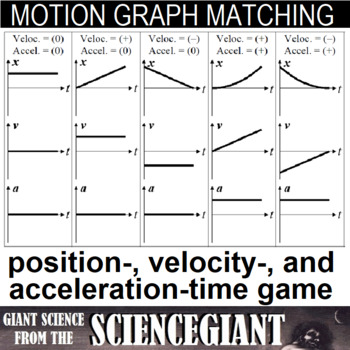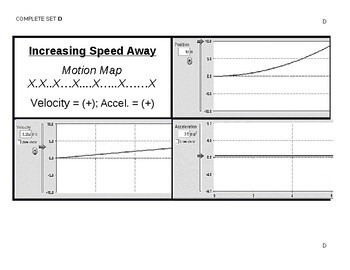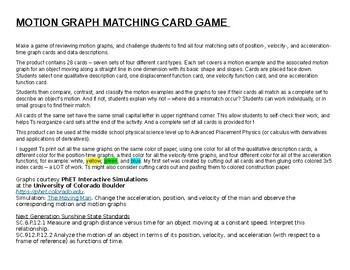Kinematics Motion Graph Matching Card Game
- Word Document File
What educators are saying
Also included in
- Kinematics is the branch of classical mechanics which describes the motion of points, bodies (objects) and systems of bodies (groups of objects) without looking at the cause of this motion. In other words, HOW? not WHY?Teachers use the Strategic Instruction Model (SIM) Framing Routine to transform aPrice $12.22Original Price $13.50Save $1.28
Description
Motion Graph Matching Card Game
Make a game of reviewing motion graphs, and challenge students to find all four matching sets of position-, velocity-, and acceleration-time graph cards and data descriptions. The product contains 28 cards – seven sets of four different card types. Each set covers a motion example and the associated motion graph for an object moving along a straight line in one dimension with its basic shape and slopes.
HOW TO PLAY:
Cards are placed face down. Students randomly select one qualitative description card, one displacement function card, one velocity function card, and one acceleration function card.
Ss then compare, contrast, and classify the motion examples and the graphs to see if their cards all match as a complete set to describe an object’s motion. And if not, Ss explain why not – where did a mismatch occur? Ss can work individually, or in small groups to find their match.
A second card game is included to review equations and their associated graphs, to challenge Ss to find matching sets of linear positive, linear negative, proportional, inverse, and quadratic graphs. The part contains 28 cards – five sets of six different card types. Each set includes a term card, an equation card, an (x,y) data table card, a graph card, and a y-intercept card, and may include a card of the slope of the line.
This product can be used at the middle school physical science level up to Advanced Placement Physics (or calculus with derivatives and applications of derivatives).
This product has been classroom tested to help students with the following Florida Next Generation Sunshine State Standards in Science:
• SC.6.P.12.1 Measure and graph distance versus time for an object moving at a constant speed. Interpret this relationship.
• SC.912.P.12.1 Distinguish between scalar and vector quantities and assess which should be used to describe an event
• SC.912.P.12.2 Analyze the motion of an object in terms of its position, velocity, and acceleration (with respect to a frame of reference) as functions of time.
Related Resources
• Question Exploration: Solve Average Velocity from a Position-Time Graph
• Question Exploration: Solve Average Acceleration from a Velocity-Time Graph
• Frame: Kinematics Equations and Formulas of Motion
• Concept Comparison: Graphs in Science (Categorical vs Numerical)
#StayGiant and stay up on my new resources and STEM news. Look for the green ★ star near the top of any page within my store and click "FOLLOW". Or follow @TheScienceGiant Twitter. Stand on The Shoulders of Giants, and together we'll see further, inspire students, and enlighten inquisitive minds!






